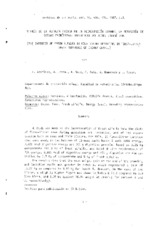Mostrar el registro sencillo del ítem
Interés de la alfalfa fresca en la alimentación durante la gestación de cerdas primíparas: influencia del nivel energético
| dc.contributor.author | Jodral Gutiérrez, A. | es_ES |
| dc.contributor.author | Domenech García, V. | es_ES |
| dc.contributor.author | Tovar Andrada, J.J. | es_ES |
| dc.contributor.author | Vera y Vega, A. | es_ES |
| dc.contributor.author | Peña Blanco, Francisco | es_ES |
| dc.contributor.author | Aparicio Ruiz, F. | es_ES |
| dc.date.accessioned | 2010-05-10T09:54:03Z | |
| dc.date.available | 2010-05-10T09:54:03Z | |
| dc.date.issued | 1987 | |
| dc.identifier.issn | 1885-4494 | |
| dc.identifier.uri | http://hdl.handle.net/10396/3219 | |
| dc.description.abstract | A study was malle of the incorporation of fresh alfalfa into the diets of first-litter sows during gestation and lactation, and of its repercussion both on sows and their litters. For this, 20 first-litter Landrace sows were used, in two batches of 10 sows each: batch A with 100% energy, 7,821 Kcal digestive energy and 301 g digestive protein, based on 2.25 Kg concentrate and 3 Kg of fresh alfalfa, and batch B with requirements of 75% energy, 6,865 Kcal of digestive energy and 254 g digestive protein satisfied by 1.7 Kg of concentrate and 5 Kg of fresh alfalfa. The results show that the sows weight gain at the end of the breeding and lactation cycle was greater in batch A, which registered a gain of 13.27 Kg as compared to 9.65 Kg for batch B. However, in the case of the litter, a slightly higher figure was shown in batch B (7.9 compared to 8.9 live birth, and 9.06 as against 10.94 weight at weaning for batches A and B, respectively). | en |
| dc.description.abstract | Se estudia la incorporación de alfalfa fresca a las dietas de cerdas de primer parto durante la gestación y lactación, y sus repercusiones, tanto en ellas como en su camada. Para ello se emplean 20 cerdas primíparas de raza Landrace distribuidas en dos lotes de 10 cada uno: un lote A, con 100% de energía, 7.921 Kcal E.D. y 301 g de P.D., cubierta a base de 2"25 kg de concentrado y 3 kg de alfalfa fresca; y un lote B con unas necesidades de 75% de energía, 6.865 Kcal E.D. y 254 g de P.D., satisfechas con 1"7 kg de concentrado y 5 kg de alfalfa fresca. Los resultados muestran un balance favorable al lote A, en lo que respecta a las ganancias en peso de las cerdas, al final del ciclo reproductivo y lactación: 13"27 kg frente a los 9"65 del lote B. Sin embargo, en, lo referente a la camada, el balance es ligeramente favorable al lote (7"9, frente a 8"9 lechones nacidos vivos; 1"155 kg, frente a 1"205 kg de peso al nacimiento; y 9"06, frente a 10"94 kg de peso al destete, para los lotes A y B, respectivamente). | es_ES |
| dc.format.mimetype | application/pdf | es_ES |
| dc.language.iso | spa | es_ES |
| dc.publisher | Universidad de Córdoba, Servicio de Publicaciones | es_ES |
| dc.rights | https://creativecommons.org/licenses/by-nc-nd/4.0/ | es_ES |
| dc.source | Archivos de zootecnia 36 (134), 3-12 (1987) | es_ES |
| dc.subject | Porcino | es_ES |
| dc.subject | Alfalfa fresca | es_ES |
| dc.subject | Caracteres reproductivos | es_ES |
| dc.subject | Alimentación animal | es_ES |
| dc.title | Interés de la alfalfa fresca en la alimentación durante la gestación de cerdas primíparas: influencia del nivel energético | es_ES |
| dc.title.alternative | The interest of fresh alfalfa in feed during gestation in first-litter sows: influence of energy level | en |
| dc.type | info:eu-repo/semantics/article | es_ES |
| dc.relation.publisherversion | http://www.uco.es/organiza/servicios/publica/az/az.htm | es_ES |
| dc.rights.accessRights | info:eu-repo/semantics/openAccess | es_ES |

